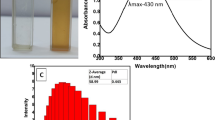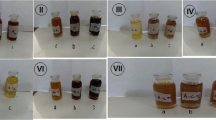Abstract
Purpose
The objectives of the study are to obtain silver nanoparticles using Anthemis tricolor in an environmentally friendly, economical, and more effective way with green synthesis and also to determine the most appropriate parameters by examining the effects of preparation conditions on particle size, polydispersity index, and zeta potential using factorial design and further to compare the bioactivity results between water extract and silver nanoparticles. Thus, it is aimed to shed light on further studies on the lightening effects of nanoparticles on the skin.
Methods
In this study, silver nanoparticles were synthesized by reduction using Anthemis tricolor water extract and silver nitrate solution. Then, various characterization methods (Ultraviolet-Visible Spectroscopy, X-Ray Diffraction analysis) were studied. In addition, the effects of incubation temperature, silver nitrate solution concentration, and extract volume on particle size, zeta potential, and polydispersity index were investigated, and optimum parameters were determined. In addition, antioxidant activities of water extract and silver nanoparticles (DPPH Radical Scavenging Activity, ABTS Radical Cation Scavenging Activity, and Cupric Reducing Antioxidant Capacity) and tyrosinase inhibitory activities were determined.
Results
According to the results, it was observed that biosynthesis took place with the absorption peak at 440 nm. In addition, changes in peak intensities and shifts in values that occur at the end of nanoparticle formation were determined by Fourier Transform Infrared Spectroscopy. Cubic morphology was determined by Scanning Electron Microscopy. The existence of (111), (200), (220) and (311) planes was proved by X-ray diffraction analysis, confirming the existence of silver nanoparticles in a cubic structure. The optimized parameters were determined for silver nanoparticles obtained by incubating 5 ml of an extract with 1 mM silver nitrate solution at 25 °C. Polydispersity index, zeta potential, and particle size values were in the appropriate range. On the other hand, it was observed than silver nanoparticles’ antioxidant and tyrosinase inhibitory activities were higher than those the water extract.
Conclusion
It was concluded that Anthemis tricolor could be presented as an effective, stable, reducing agent. It also suggested that it can be used due to its antioxidant and tyrosinase inhibitory activities and directed to further studies for skin-lightening preparations.







Similar content being viewed by others
Data Availability
All data materials are avalilable.
References
Jeevanandam J, Barhoum A, Chan YS, Dufresne A, Danquah MK. Review on nanoparticles and nanostructured materials:history, sources, toxicity and regulations. Beilstein J Nanotech. 2018;9:1050–74. https://doi.org/10.3762%2Fbjnano.9.98.
Kavitha KS, Syed B, Rakshith D, Kavitha HU, Yashwantha Rao HC, Harini BP, Satish S. Plants as green source towards synthesis of nanoparticles. Int Res J Biol Sci. 2013;6:66–76.
Yilmaz M, Turkdemir H, Kilic MA, Bayram E, Cicek A, Mete A, Ulug B. Biosynthesis of silver nanoparticles using leaves of Stevia rebaudiana Mater. Chem. Phys. 2011; 130: 1195–1202. https://doi.org/10.1016/j.matchemphys.2011.08.068.
Kotakadi VS, Goddam SA, Venkata SK. Ficus fruit -mediated biosynthesis of silver nanoparticles and their antibacterial activity against antibiotic resistant E.coli strains. Curr. Nanosci. 2015; 11(4): 527–538. https://doi.org/10.2174/1573413711666150126225951.
Goddam SA, Kotakadi VS, Gopal DVRS, Rao YS, Reddy AV. Efficient and robust biofabrication of silver nanoparticles by Cassia alata leaf extract and their antimicrobial activity. J Nanostructure Chem. 2014;4:73–82. https://doi.org/10.1007/s40097-014-0082-5.
Baghizadeh A, Ranjbar S, Gupta VK, Asif M, Pourseyedi S, Karimi MJ, Mohammadinejad RJ, Mol. Liq. 2015;207:159–63. https://doi.org/10.1016/j.molliq.2015.03.029.
Ajitha B, Ashok KRY, Sreedhara RP. Green synthesis and characterization of silver nanoparticles using Lantana camara leaf extract mat. Sci Eng C. 2015;49:373–81. https://doi.org/10.1016/j.msec.2015.01.035.
Leonard K, Ahmmad B, Okamura H, Kurawaki. J. In-situ green synthesis of biocompatible Ginseng Capped gold nanoparticles with remarkable stability. Colloids Surf B-Bio-Interfaces. 2011;82(2):391–6. https://doi.org/10.1016/j.colsurfb.2010.09.020.
Wang Y-X, Su W-C, Wang O, Lin Y-F, Zhou Y, Lin L-F, Ren S, Li Y-T, Chen Q-X, Shi Y. Antityrosinase and antioxidant activities of guanidine compounds and effect of guanylthiourea on melanogenesis. Process Biochem. 2019;85:84–96. https://doi.org/10.1016/j.procbio.2019.07.003.
Zolghadri S, Bahrami A, Khan MTH, Munoz-Munoz J, Garcia-Molina F, Garcia-Canovas F, Saboury AA. A comprehensive review on tyrosinase inhibitors. J Enzyme İnhib Med Chem. 2019;34:279–309. https://doi.org/10.1080%2F14756366.2018.1545767.
Davis PH. Flora of Turkey and East Aegean Islands. Edinburgh: Edinburgh University; 1984.
Karaalp C, Erel SB, Nalbantsoy A, Gucel S, Demirci B, Baser KHC. The essential composition of aerial parts of Anthemis Tricolor Boiss. From Cyprus. Nat Prod Res. 2014;28(7):488–91. https://doi.org/10.1080/14786419.2013.867857.
Sut S, Dall’Acqua S, Zengin G, Senkardes İ, Bulut G. Influence of different extraction techniques on the chemical profile and biological properties of Anthemis cotula L.: Multifuncitonal aspects for potential pharmaceutical applications. J Pharm Biol Sci. 2019;173:75–85. https://doi.org/10.1016/j.jpba.2019.05.028.
Djeridane A, Yousfi M, Najdemi B, Vidal N, Lesgards JF, Stocker P. Screening of some Algerian medicinal plants for the phenolic compounds and their antioxidant activity. Eur Food Res Tech. 2007;224:801–9. https://doi.org/10.1007/s00217-006-0361-6.
Gür M, Güder A, Verep D, Güney K, Özkan OE, Seki N, Kandemirli F. Some important plants for epilepsy treatment: antioxidant activity and flavonoid compositions. Iran J Sci Technol Trans Sci. 2018;42:1847–57. https://doi.org/10.1007/s40995-017-0361-3.
Belhaoues S, Amri S, Bensouilah M. Major phenolic compounds, antioxidant and antibacterial activities of Anthemis praecox Link aerial parts. S Afr J Bot. 2020;131:200–5. https://doi.org/10.1016/j.sajb.2020.02.018.
Bursal E, Aras A, Kılıç Ö, Buldurun K. Chemical constituent and radical scavenging antioxidant activity of Anthemis kotschyana Boiss. Nat Prod Res. 2020; online. https://doi.org/10.1080/14786419.2020.1723089.
Sarıkürkçü C. Anthemis Chia: Biological Capacity and phytochemistry. Ind Crops Prod. 2020;153:112578. https://doi.org/10.1016/j.indcrop.2020.112578.
Ghamipoor S, Fayyazi F, Bahadorikhalili S. Phytochemical synthesis of silver nanoparticles using Anthemis nobilis extract and its antibacterial activity. Z Phys Chem. 2020;234(3):531–40. https://doi.org/10.1515/zpch-2018-1288.
Pourmortazavi SM, Taghdiri M, Makari V, Rahimi-Masrabadi M. Procedure optimization for green synthesis of silver nanoparticles by aqueous extract of Eucalyptus oleosa. Spectrochim Acta Mol Biomol Spec. 2015;136:1249–54. https://doi.org/10.1016/j.saa.2014.10.010.
Ekaji FA, Akujobi CO, Umeh SI. Optimization of selected process parameter affecting yield of green synthesized silver nanoparticles and their antibacterial activity. Biotechnol J Int. 2021;25(2):25–36. https://doi.org/10.9734/BJI/2021/v25i230136.
Pasupuleti VR, Prasad T, Shiekh RA. Biogenic silver nanoparticles using Rhinacanthus Nasutus leaf extract:synthesis, spectral analysis, and antimicrobial studies. Int J Nanomed. 2013;8:3355–64. https://doi.org/10.2147/IJN.S49000.
Awwad AM, Salem NM. A green and facile approach for synthesis of magnetite nanoparticles. Mater Lett. 2012;2(6):208–13. https://doi.org/10.5923/j.nn.20120206.09.
Dinesh S, Karthikeyan S, Arumugam P. Biosynthesis of silver nanoparticles from Glycyrrhiza glabra root extract. Arch Appl Sci Res. 2012;4:178–87.
Chunyan W, Valiyaveettil S. Correlation of biocapping agents with cytotoxic effects of silver nanoparticles on human tumor cells. RSC Adv; R Soc Chem. 2013;3:14329–38. https://doi.org/10.1039/c3ra41346b.
Esmaeili MA, Sonboli A. Antioxidant, free radical scavenging activities of Salvia branchyantha and its protective effect against oxidative cell injury. Food Chem Toxicol. 2010;48:846–53. https://doi.org/10.1016/j.fct.2009.12.020.
Rer A, Pellegrini N, Proteggente A, Pannola A, Yong M, Rice-Evans C. Antioxidant activity applying an improved ABTS radical cotion decolorization assay. Free Rad Biol Med. 1999;26:1231–7. https://doi.org/10.1016/S0891-5849(98)00315-3.
Apak R, Güçlü K, Özyürek M, Karademir SE. A novel total antioxidant capacity index for dietarypolyphenols, vitamin C and E, using their cupric ion reducing capability in the presence of neocuproine: the CUPRAC method. J Agric Food Chem. 2004;52:7970–81. https://doi.org/10.1021/jf048741x.
Masuda T, Yamashita D, Takeda Y, Yonemori S. Screening for tyrosinase inhibitors among extracts of seashore plants and identification of potent inhibitors from Garcinia Subelliptica. Biosci Biotechnol Biochem. 2005;69:197–201. https://doi.org/10.1271/bbb.69.197.
Riaz M, Ismail M, Ahmad B, Zahid N, Jabbour G, Khan MS, Mutreja V, Sareen S, Rafiq A, Faheem M, Shah MM, Khan MI, Bukhari SAI, Park J. Characterizations and analysis of the antioxidant, antimicrobial, and dye reduction ability of green synthesized silver nanoparticles. Green Process Synth. 2020;9:693–705.
Sahudin S, Ayumi NS, Kaharudin N. Enhancement of skin permeation and penetration of Arbutin fabricated in Chitosan Nanoparticles as the Delivery System. Cosmetics. 2022;9:114. https://doi.org/10.3390/cosmetics9060114.
Gupta V, Mohapatra S, Mishra H. Nanaotechnology in cosmetics and Cosmeceuticals- A review of latest advancements. Gels. 2022;8:173. https://doi.org/10.3390/gels8030173.
Sindhu PD, Mukerjhee A, Chandrasekoran N. Phytosynthesis of silver nanoparticles using Ceriops tagal and its antimicrobial potential against human pathogens. Int J Pharm Pharm Sci. 2013;5(3):349–52.
Nayak RR, Pradhan N, Behera D, Pradhan KM, Mishra S, Sukla LB, Mishra BK. Green synthesis of silver nanoparticle by Penicillium Purpurogenum NPMF: the process and optimization. J Nanopart Res. 2011;13:3129–37. https://doi.org/10.1007/s11051-010-0208-8.
Jalab J, Abdelwahed W, Kitaz A, Al-Kayali E. Green synthesis of silver nanoparticles using aqueous extract of Acacia cyanophylla and its antibacterial activity. Heliyon. 2021;7:e08033. https://doi.org/10.1016/j.heliyon.2021.e08033.
Coates J. Interpretation of infrared spectra, a practical approach. In: Meyers RA, editor. Encyclopedia of Analytical Chemistry. Chichester: John Wiley&Sons Ltd.; 2000. pp. 10815–37. https://doi.org/10.1002/9780470027318.a5606.
Baharara J, Namvar F, Ramezani T, Mousavi M, Mohamad R. Silver nanoparticles biosynthesized using Achillea biebersteinii flower extract: apoptosis induction in MCF-7 cells via caspase activation and regulation of Bax and Bcl-2 gene expression. Molecules. 2015;20:2693–706. https://doi.org/10.3390/molecules20022693.
Ozer O, Kozmetoloji. Ege Üniversitesi Eczacılık Fakültesi Yayınları, 2020. no:4, İzmir.
Ozer O, Ozguney I, Farmasötik Teknoloji I. Ege Üniversitesi Eczacılık Fakültesi, 2022; Yayın No: 7, İzmir.
Morganti PDel Ciotto P, Carezzi F, Guarneri F, Jui Yeo Y. Skin lightening efficacy of New formulations enhanced by Chitin nanoparticles Delivery System. J Appl Cosmet. 2014;32:57–71.
Gajbhiye S, Sakharwade S, Silver Nanoparticles in Cosmetics. J Cosmet Dermatol Sci Appl. 2016;6:48–53. https://doi.org/10.4236/jcdsa.2016.61007.
Smijs TGM, Bouwstra JA. Focus on skin as a possible port of entry for solid nanoparticles and the toxicological impact. J Biomed Nanotechnol. 2010;6:469–84. https://doi.org/10.1166/jbn.2010.1146.
Salvioni L, Morelli L, Ochoa E, Labra M, Fiandra L, Palugan L, Prosperi D, Colombo M. The emerging role of nanotechnology in skincare. Adv Colloid Interface Sci. 2021;293:102437. https://doi.org/10.1016/j.cis.2021.102437.
Khoskhoo MEK, Nematollahi F. Flavonoid content of Anthemis tinctoria and its application for green synthesis of silver nanoparticles. J Pharmacogn Phytochem. 2015;5(1):264–6.
Dehghanizade S, Arasteh J, Mirzaie A. Green synthesis of silver nanoparticles using Anthemis Atropatana extract: characterization and in vitro biological activities. Artif Cells Nanomed Biotechnol. 2018;46(1):160–8. https://doi.org/10.1080/21691401.2017.1304402.
Ajlouni A-W, Hamdan EH, Alshalawi RAE, Shaik MR, Khan M, Kuniyil M, Ansari A, Alwarthan MA, Khan M, Alkhathlan HZ, Shaik JP. Adil SF Green synthesis of silver nanoparticles using aerial part extract of the Anthemis pseudocotula Boiss. Plant and their biological activity. Molecules. 2023;28:246. https://doi.org/10.3390/molecules28010246.
Fafal T, Taştan P, Tüzün BS, Özyazıcı M, Kıvçak B. Synthesis, characterization and studies on antioxidant activity of silver nanoparticles using Asphodelus Aestivus Brot. Aerial part extract. S Afr J Bot. 2017;112:346–53. https://doi.org/10.1016/j.sajb.2017.06.019.
Şener İ, Gür M, Verep D, Güney K, Altuner EM. Antimicrobial activities and some flavonoids in extracts of some Medicinal plants. Indian J Pharm Educ Res. 2017;51:234–8. https://doi.org/10.5530/ijper.51.3s.20.
Orlanda G, Zengin G, Ferrante C, Ronci M, Recinella L. Comprehensive chemical profiling and multidirectional biological investigation of two wild Anthemis species (Anthemis tinctoria var. Pallida and A. Cretica subsp. tenuiloba. Molecules. 2019;24:2582. https://doi.org/10.3390/molecules24142582.
Funding
We would like to thank Ege University BAP project number 23247 for financially supporting the research.
Author information
Authors and Affiliations
Contributions
All authors contributed to the study conception and design. Material preparation, data collection and analysis were performed by [Burcu Sümer Tüzün], [Tuğçe Fafal], [Işık Özgüney] and [Bijen Kıvçak]. The first draft of the manuscript was written by [Burcu Sümer Tüzün] and all authors commented on previous versions of the manuscript. All authors read and approved the final manuscript.
Corresponding author
Ethics declarations
Ethical Approval
Ethical approval is not needed. All authors are constent to participate and publish the manuscript.
Conflict of Interest
All authors state there are no conflict of interest.
Additional information
Publisher’s Note
Springer Nature remains neutral with regard to jurisdictional claims in published maps and institutional affiliations.
Rights and permissions
Springer Nature or its licensor (e.g. a society or other partner) holds exclusive rights to this article under a publishing agreement with the author(s) or other rightsholder(s); author self-archiving of the accepted manuscript version of this article is solely governed by the terms of such publishing agreement and applicable law.
About this article
Cite this article
Tuzun, B.S., Fafal, T., Ozguney, I. et al. Green Synthesis of Silver Nanoparticles by Using Anthemis Tricolor Boiss., Factorial Design for Parameter Optimization, Characterization and In-Vitro Biological Activities. J Pharm Innov 19, 32 (2024). https://doi.org/10.1007/s12247-024-09842-w
Accepted:
Published:
DOI: https://doi.org/10.1007/s12247-024-09842-w




